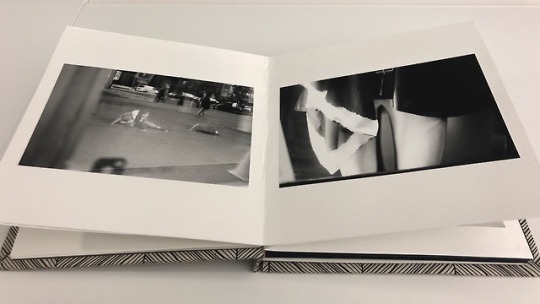Photo
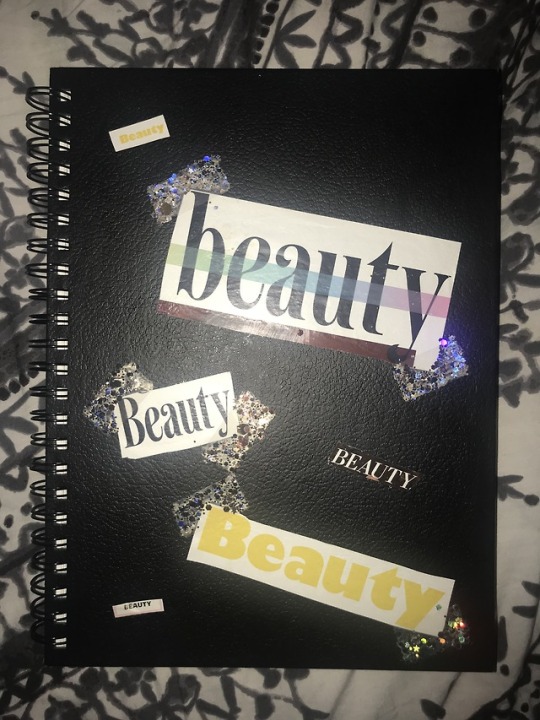
In the 21st century, girls are being heavily influenced by mass media. This influence in many ways is negative. Girls begin to compare themselves to the models they see online, in magazines, on posters, and on TV. It starts with this generalized view of what “beauty” is that starts to destroy the way girls look at themselves compared to others. It seems as though they are never good enough.
Being an 18 year old girl, I experience all of these things myself. I struggle with self confidence as I am constantly comparing myself to the people I see on social media every day and on multiple other platforms as well. Through this project I wanted to show the progression of how seeing these pictures of “beauty” can affect the way girls value themselves. I chose to photograph a singular model to show her own story to relate to girls worldwide. In many ways the photos are dramatic, but they are able to showcase the harsh reality we live in. I used mirrors continuously in the project for several different artistic reasons. I wanted to capture my subject looking at her reflection since it was one of the easiest ways to get my point across, and it is something girls are constantly doing more than they should. Her facial expression that is captured as she stares at her body hints to the viewer feelings of being unconfident, unhappy and discontent. By writing words on the mirror and on her body, I was able to show feelings and messages with the image itself that I would not have been able to capture without the words there.
I was heavily influenced by Lauren Greenfield in this project. Her project, “Girl Culture” showcases some of the same ideas, but dives into a wide variety of what being a girl is all about. Greenfield used documentary photography in her project, while I staged my photographs. Although the method of capturing the photographs were different, I still tried to use similar ideas in the images overall message.
Media creates one definition of “beauty.” It is defined in ways that are unachievable, leaving girls trying to attain something that is nonexistent. This piece of art shows the struggle of wanting to be something you’re not. In the final photographs we can see how society defines women; we can try and forget about what they have called us, but the words and pain will never go away.
By Ashley Storino
0 notes
Link
Alice Chen’s Photography Final Presentation
(contains 20 photos and introduction)
0 notes
Text
Artist Statement
Alice Chen
Final Project Artist Statement
Lights and People
This project means to capture and explore the interaction of people and lights, and the emotions created in their interplay. I used a Canon 35mm camera to shoot my project photos, and they were shot in both New York and Los Angeles, mainly in daylight. Some were in the nighttime.
I always think light is an unique existence in the world. Camera operates under the proper light setting. Human sees truth under the lights. Plants lives with the lights. Lights have a deep connection with anything it covers, and the things that are reflected back, are not just another light, but being added another layer of personal meaning. White light contains seven colors, which its rich hues should be better expressed by color photos. However, it is the black and white film that strips off color’s illusionary filter. In the stark contrast of black and white, lights only exist in the pure form and function, just for lighting the objects, and being as a medium of emotion conveyance.
Lights in my project are divided into 2 categories: artificial and natural. Artificial lights are the indoor lights, or any lights that are humanly made, or supported by electricity. Natural lights are sunlight, or moonlight. I found that under the artificial lights, people will start to put on a mask for acting, just as the word “artificial” shows. There is always something on people’s faces that are covering their true inner feelings, which can be shown on the restricted smile, actions or aloof look. In the sunlight or moonlight, people are willing to express more, less hiding from the instincts, which can be found in the smooth and candid postures. Even with the lifeless substances, there are different levels of truth unveiled under artificial and natural lights.
Artificial lights are the fake “natural lights” created under the advanced technology in the contemporary society. As the world evolves, the human get more cultured. Not just need to harvest on farms. Human need to read, work or play during night time, or in the buildings that nature lights cannot reach. Thus, artificial lights came as a sign of civilization, an artificial layer that people put on themselves. Even the food under the artificial lights has a sense of exquisiteness. However, we should be back to natural lights as much as possible, to retain the innocent, unaffected part of the human.
Under the influence of Nan Goldin, I tried to focus less on the formality and trite rules of shooting, just pick the proper lights, and then follow my hearts to press the shutter.
In the photo with three female mannequin, I intentionally shot at an downward angle, to better present a glossy texture on the mannequin, and a haughty facial expression under the strong, direct light from a near pendant lamp. The plastic phoniness and the lifeless unreality can only be revealed under the artificial light. If this photo was taken under the warm sunlight, then maybe there will be another brand new illustration of the mannequins.

In the photo with an old man operating puppets with two little boys standing by, here is where natural daylight plays a role. The expression of the little boy is very candid and unaffected. Although the old man’s facial expression is dodged, there is still a flow of naturalness held in his gentle body language. If this photo was taken in an indoor setting, for example, on stage. Then perhaps the magnesium light will make the people seem weird, and feel like they are in some drama shows.

0 notes
Text
Nan Goldin Mini-Research Paper
Alice Chen
Nan Goldin is internationally renowned for her candid and lawless photography, featuring the topics of love, death, sexuality and free will. She was quite rebellious in her younger ages. She usually ran away from home — her so-called “respectable world” comprised of her parents and the Jewish household she was brought up in. Nan Goldin tried her hand at photography in school, and put her first show in Boston in 1973. After moving to New York in 1989, she started to photograph heavily on her close friends’ daily scenes (such as making love in messy apartments) as well as lives of Bowery’s drag queens. The two bodies of work I would like to compare and contrast are The Ballad of Sexual Dependency and Nine Self-portraits.
The Ballad of Sexual Dependency is Nan Goldin’s largest and most famous body of work, which contains more than 700 snapshot-like photographs, including both black and white and color versions, representing the post-punk era of hard drugs and sexual indulgence. This body of work delineates her life as a deep personal narrative, and forms out her own experiences mostly around Boston, New York, Berlin in the late 1970s, 1980s and beyond. The Ballad of Sexual Dependency is titled after a song in Bertolt Brecht and Kurt Weill’s The Threepenny Opera. Goldin’s life is a kind of opera to me, since the protagonists and artist herself in her work’s most intimate moments are captured and displayed in a flow of love and loss.
Through this work, Goldin not only wanted public to notice about the AIDS, the minority, but also wanted to keep these photographs as her special memory. “The Ballad of Sexual Dependency is the diary I let people read,” Goldin wrote. “The diary is my form of control over my life. It allows me to obsessively record every detail. It enables me to remember.” This body of work’s theme is mainly focus on the people on the edge, for instance, club dancers and drag queens, people who suffer from domestic violence or AIDS, and their experience of “ecstasy,” pain through sex and drug use. There are two photos that catches my eyes when I look at them: “Misty and Jimmy-Paulette in a taxi” (1991), and “Nan and Brian in Bed” (1981).
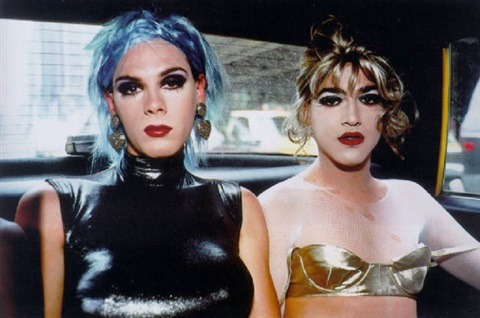
In this portrait Misty and Jimmy-Paulette in a taxi (1991), there are two drag queens sit in the back of the taxi. Looking outside the window, the outline of the steel bridge can be seen. There is a typical New York City vibe, and the camera flash highlights the subjects’ heavy makeup and shiny, glossy outfit. Misty is the one on the left with blue hair, and Jimmy is on the right who is wearing a sleek gold dress. They both directly look at the camera with a slightly contemptuous, bored, and tired emotion, which is a far cry from the magnificent personas they would put on the performance show at night clubs. And this is a very close-up shot with the genuine emotion, which means Goldin probably is their close friend.
Nan Goldin’s body of work was greatly influenced by photographer Larry Clark’s Tulsa (1971), which is a collection of black and white photos delineating teenagers from Oklahoma having sex, carrying guns. Goldin seemed to like the life staying away from convention, banality, and appreciate scenes of lawlessness. She wants to show life just as its original state, without the staged subjects. Everything photographed by her is a straightforward moment without disguise, that can never be replicated.

Just as another photo Nan and Brian in Bed (1981), is a stark moment of Nan Goldin’s memory. The woman in the bed is Nan Goldin herself. She intended to chronicle her intimate relationships. The man stood there with his back turned, and Goldin her eyes watching him, “she made public a typical private experience of woman as gendered beings.” (Angelad, Art Thoughts)
Another project called Nine Self-Portraits shows Nan Goldin’s recent photographs that are never been exhibited before. This body of work (spanning back to the 1990s) is “diaristic and contemplative … Goldin shares very personal images of desire, intimacy and introspection.” (Fraenkel Gallery) The nine photos all have rich colors, deep shadows and lush textures.

This is the Self-portrait on the train, taken on Goldin’s trip from Boston to New Haven, in the year of 1997. In this photo, the composition just happens right in its perfect angle. The disappearing scenery outside the window, along with the windowsill, drags an upward line from left bottom to right top, adding a spatial depth to the photo. Here she conveys a sense of nostalgia.

Nan Goldin photographed herself in a retro style mirror in this photo: In the mirror at Alberto’s Pallazzo, which was taken in Venice, Italy, October 2013. The mirror surface is too dirty to see Nan’s clear facial details. We can only catch her blur contour. The camera focuses mainly on mirror’s stains, combining with the dark theme in this photo, giving out a sense of aloofness, objectiveness and a few sadness, intriguing the audience’s curiosity to further dig her personal life.
The Nine Self-Portraits and The Ballad of Sexual Dependency’s conspicuous difference is their project’s vision anchor point. The Ballad of Sexual Dependency concentrates on the vision of how Nan Goldin looks at the life and people, love and hate happened around her, while in Nine Self-Portraits, it is the vision from herself, how she regards herself and her inner emotion, that she wants to present to the public. In The Ballad of Sexual Dependency, Goldin emphasizes on revealing her private life to let public discover the social problem and the life situation of the group on the edge, it’s an extrovert-type of work. However, in Nine Self-Portraits, she was less insisted on using her photos as tools to express some belief or calling for attention. In these nine photo, she intends to search for a serenity in heart, look into the state of her mind, and try to capture herself as the main character. These two bodies of work have the differences on purpose, emotion, and different background stories, but the similarity is also noticeable, that is Nan Goldin’s indelible photographic style and technique. She is good at taking photos in a casual while charming way. Even though each photos’ characters or things are distinct from each other, she is able to let a sense of lawlessness and naturalness flow in her arts.
0 notes
Text

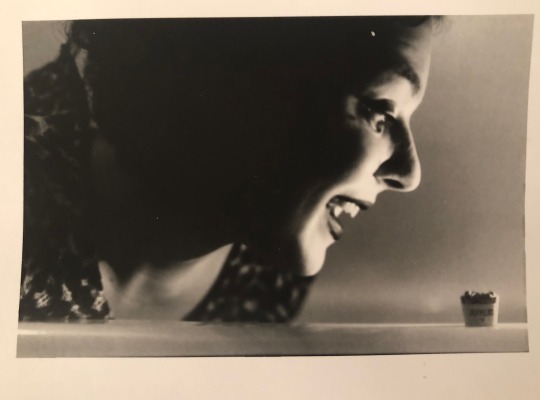

“The Tiny” is a series of self-portraits, but they are not exactly portraits of me. In the photos, I am a character, a girl with a disturbance of identity and a flair for the dramatic. She puts on heavy stage makeup and plays with miniature toy food. As far as one can tell, she spends her days alone, inhabiting whatever fantasy becomes her. Her world grows smaller as she shrinks further into herself.
Like many, I have always been inspired by Cindy Sherman, and her “Untitled Film Stills” played a large part in my inspiration for this project. I admire Sherman for her commitment to performance. I wanted to see how I might incorporate performative elements into my own work. For me, this project moved beyond photography and into the theatrical; not only was I creating images, I was also playing a role.
This role does not seek sense per say; I am less concerned with telling a linear story than I am in presenting the strangeness of self-recognition. I struggled with this project not only from a technical standpoint, but also a personal one. I tend to hate photos of myself, so, needless to say, the choice to do a self-portrait series required a particular vulnerability on my end. I believe we all, to some degree, experience a simultaneous fixation and horror at our own image; we dread the sight of ourselves and yet it keeps us fully engrossed. I wanted to play with my own “self-horror” while creating these images; the result is a character whose plight and behaviors are more than a little nonsensical. But I believe this holds some truth to my own conception of identity, and perhaps for other’s too: it’s difficult for me to rationalize this idea of “the self.” So instead, I choose to live comfortably with the nonsense of it all.
--Sophia
0 notes
Photo

In my photo book “Never Normal, Never Perfect, Never Loved”, I moved the lens back and forth to depict the mental and emotional experience as well as typical behaviors of being one of the victims of Anorexia Nervosa (NA) when it was fiercest. I chose not to directly shoot skinny bodies, which may lead to misunderstandings that anorexia is always accompanied by deformity and is far from a normal life. That’s not the case, though.
People that are trapped by anorexia are always two-sided. On one hand, they are eager to escape from this eating disorder. On the other hand, however, they are somehow addicted to the situation where everything seems under control. These two conflicting sides tear them apart, pulling them gradually from normal girls or boys who care a little more about their figures to the cliff of mental disease. Longing to be loved and never satisfied with their body, they desperately attribute any social frustrations to the imperfection of their appearance. Thus, the fear of gaining weight gets so strong that it even outweighs the fear of death.
As William Blake wrote in “Auguries of Innocence”,
“To see a World in a Grain of Sand,
And a Heaven in a Wild Flower”.
I believe abstract scenes and objects can be used to convey strong emotions. Metaphors are inserted throughout the narrative to underline specific mental stages: overpowered, distorted, afraid, revealed, locked, failed......With rich details and the solemn atmosphere offered by 35mm black and white film, the project aims to offer family members, friends and loved ones of the victims of anorexia access to the inner sufferings.
Chunhan Chen
P.S. Thanks, everyone! This is the warmest class I’ve ever enrolled in:)
0 notes
Photo
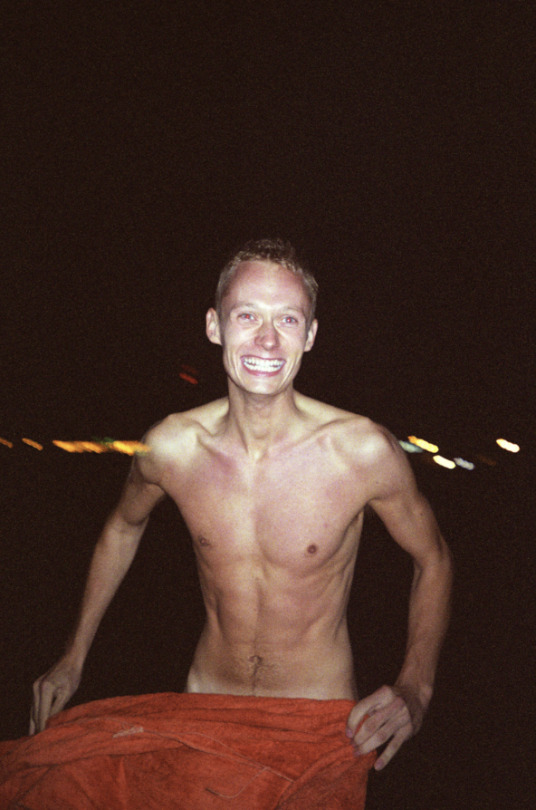

Ryan McGinley
The bodies of work I chose to focus on by Ryan McGinley are, The Kids Were Alright and Paradiso. These works are drastically different and fully capture the growth McGinley has experienced over time. The Kids Were Alright was his first great work which consisted of “documentary-style approach captured the antics and daily activities of himself, his friends, and collaborators in lower Manhattan in the late 1990s” as well as 1,500 polaroids from the time. This body of work was shown in 2002, fifteen years before Paradiso. His more recent work, Paradiso does not have the same spontaneity as his earlier works but shows a more precise focus on his subject. While these images are more calculated they are still, “preserving the exuberance of a candid image” (Ratio 3) that is commonly observed throughout his work.
Ryan McGinley started going to the city “to visit his older brother, who was gay, dressed in drag and lived with his partner on the Upper East Side” (Abrams). We see that he started off his experiences in the city with a unique perspective on the world. I believe that this is one of the influences behind the way he chooses his subjects. Mcginley went to Parsons School of Design with the intention of studying painting. Over time he changed his focus to poetry, then to graphic design and finally after “taking a class with George Pitts titled ‘Nudity, Sexuality and Beauty in Photography’” (Abrams), he decided to study photography. This class has clearly influenced his work till this day. Most of his subjects are captured in the nude.
In a conversation with Dan Colen, Ryan McGinley stated that he, “just desperately wanted to get into art school, and get the fuck out of the suburbs” (Colen). This motivation to get into the city is one all too familiar. The urge to leave the home we grow up in to get to the pull of New York was what drives him to excellence. It is possible to draw a correlation from his urge to prove himself to the success he had at such a young age. He was only twenty-six when he “had his first major solo show in New York—at the Whitney Museum of American Art” (Mills). He was the youngest person to have a solo show at the Whitney in thirty years.
While most of his pictures tend to be taken in a landscape orientation, I will compare two of his pieces taken in portrait. These photographs are taken fifteen years apart and the difference in quality is astonishing. One may even mistake them for being taken by two different artists. Quite frankly the only similarities between these pictures are they are both images of a single person and these people happen to be skinny and white. These images are both quite intimate in different ways. Otherwise, these images are drastically different. The image titled, Oliver (Orange) was taken in 2002, it is clear that this image was candid and sporadic. The background is little except blurred city lights in the dark, and he has clearly been captured mid-motion. Also, he has red-eye in the photo which shows the lack of precision and quick nature of this photograph. This image was captured with a shallow depth of field, most likely because McGinley did not have the time to adjust his camera to the situation. This image also has a much lower resolution than Chloe which is an entirely different type of photograph. It had a higher resolution which also shows the passage of time, the quality of cameras drastically improved over the last fifteen years which is evident in the work.
The most glaring difference in the two images is the background, this image is taken during the day in a natural setting while Oliver (Orange) was taken in a city. Also, the focus of the image doesn't seem to be just the woman as was the case in Oliver (Orange). Chloe is in deep focus because it has a great depth of field. The woman is one with nature and the entire image is sharp and detailed. If any part if the image is blurred it would be the woman, it’s as if she were meant to be hidden in the background. One common element in both images is the use of vibrant color that draws you in. Both images warrant a second glance. Chloe shows us the more refined art that McGinley strived to create.
We can see in Oliver (Orange) that this person seems to be a friend because of their calm demeanor in the image. It is not a simple task to take quality candids it is clear that they are friends. McGinley talks about this exhibition and the people who are in it. These people were his friends, “have become very successful artists in their own right, a lot of people have unfortunately passed away from overdoses or suicide” (52 Insights). The intimacy between the subject and photographer is clear in his body of work called, The Kids Were Alright because he was close to them. The relationships in Paradiso are much more professional which is to be expected with time. Both bodies of work have their own special qualities. The Kids Were Alright was raw and powerful because he was capturing honest moments which mirrored life. Paradiso was beautiful in a different way, the different body types hidden amongst nature in a beautiful symbiotic relationship. Both works of art tell a story with each image the art has simply evolved over time.
What is interesting about his work is he does not take photos manually. “I’m not a technical photographer, I always put it on automatic and it doesn’t matter what camera I use because to me that isn’t what makes a picture great” (52 Insights). He perfected his craft by practice, “I’ve been shooting with Polaroid cameras since the end of the ’90s,” he says. “I started this project of mine when I was a young artist, where I would photograph everyone who came over to my apartment from 1998 to 2003. I kind of lived in a flophouse in the East Village and everyone would sleep over and come through. I shot several thousand Polaroids of people during that period” (Bateman). This casual free shooting of guests turned into part of his first body of work to get real recognition, The Kids Were Alright.
Bibliography:
Bateman, Kristen. “Ryan McGinley's Top Tips for Taking Stylish Travel Photos.” Vogue, Vogue, 19 Oct. 2017, www.vogue.com/article/ryan-mcginley-polaroid-travel-photography
“Dan Colen, 2017.” RYAN McGINLEY, ryanmcginley.com/dan-colen-2017/
Mills, Mike. “Ryan McGinley.” Interview Magazine, 1 Dec. 2016, www.interviewmagazine.com/art/ryan-mcginley-1.
“Nora Abrams, 2017.” RYAN McGINLEY, ryanmcginley.com/nora-burnett-abrams/
“Ryan McGinley.” MCA Denver, mcadenver.org/exhibitions/ryan-mcginley
“Ryan McGinley: 'New York Was Melting In Front Of Me'.” 52 Insights, 15 Aug. 2017, www.52-insights.com/ryan-mcginley-photographer-new-york-was-melting-in-front-of-me-kids-were-alright/
“The Expansive ‘Paradiso’: Ryan McGinley's New Photographs @ Ratio 3, San Francisco.” Juxtapoz Magazine - Home, www.juxtapoz.com/news/photography/the-expansive-paradiso-ryan-mcginley-s-new-photographs-ratio-3-san-francisco/
Victoria Abraham
0 notes
Link
0 notes
Photo



Alex Kary
Selfish
It could look like a project of selfies, but that belittles what a self portrait really is. I think of self portraits as capturing one moment of who I was but I won’t be again. I can try to put on the same outfit and do my hair the same way and give the same expression, but I won’t ever be exactly the same again. I like to be able to look back at these photos I’ve taken and think about how I felt in that moment or what was different in that moment. Taking a self portrait on film presents an interesting challenge different than the selfie taken on your phone. Your phone always finds the focus for you but when using my 35mm camera I must guess how far I am about to hold the camera from myself and just hope I guessed right when I go to print. When I take one of these self portraits using my reflection I must set the focus while the camera is in front of my face yet I am then moving the camera in order to not cover myself. Once again, I hope the focus was set correctly. When shooting, I had only myself in mind. This series of photos is for myself as documentation. Presenting it to an audience is a way to be more vulnerable for myself and in some ways make myself more uncomfortable.
0 notes
Photo

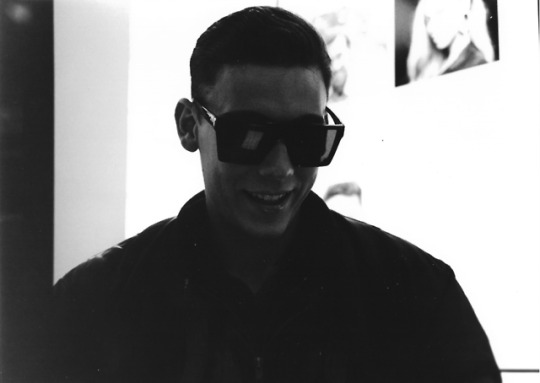
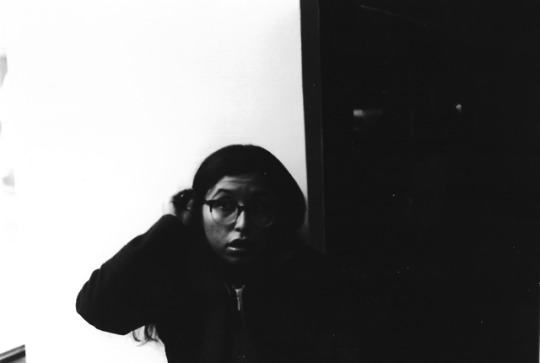
Behind the Numbers
Since moving to New York I have been fascinated by a new world I am surrounded by. In particular, the access I now have to all the celebrities I have grown up watching. Now, in this new age of social media, fans are on a different level. Whether it’s is a tweet or an in-person conversation, we interact with the people we idolize on a daily basis which makes our relationship with them that much stronger.
This new world of fandoms is unprecedented and has grown immensely. Fans are some of the most dedicated people out there and are always willing to go to the next level. While in every situation there will always be extremes, at the end of the day, we are all fans. We all look up to someone. Whether it be Beyonce or Jesus, we all have an idol. If we have the opportunity to meet those idols, we take it.
Upon moving to the city, I discovered my utopia, Build Studio. They are a celebrity interview station, in which fans can attend recordings, making up the audience. I have had the privilege of attending these interviews and meeting stars, sometimes waiting hours on end for a moment with them. In the eternity I've spent waiting outside (worth it), I've had the opportunity to see my fair share of celebrities. I’ve also gotten to know the fans who regularly attend, making strong friendships along the way. Although each fan has their own interests, the one thread tying us all together is our love for the creators.
Fans can be found everywhere, from movie theaters and Christmas tree lightings to time square, because everyone is a fan of something. We like to determine fame by the number of followers someone has, and most of the time fans are seen as just numbers. My goal for these photos was to show a behind-the-scenes of fans. This project was meant to show the people behind the numbers. Each number represents a human being, dedicated to their own interests. Once we realize that these numbers are actual individuals, only then can we understand their magnitude.
I believe that we focus so much on the celebrities that we don't take the time to appreciate the people who make them famous.
Victoria Abraham
0 notes
Text
Through The Glasses


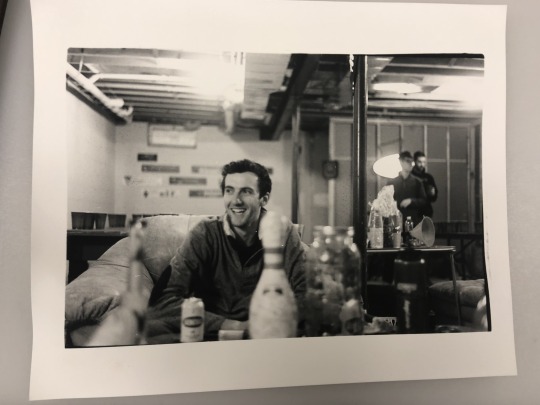
It’s been nearly two years since I moved out of my home and started my new life here in New York City. New York has always been a dream of mine but leaving the place where I’ve called home for 8 great years is never easy. Rochester is completely different than New York. These two places have their own personality and characteristics, and quite frankly they are the opposite of each other in almost every single way. New York is the city of opportunities; people come here with dreams, ambitions and a goal of making a name for themselves. Rochester is the city for families, where people move to start a family, and its diversity is no where near New York’s. After about two years of living in New York, I came to realization that I don’t find the sense of “home” in this city as I did in Rochester. Everyone is too busy living their own lives and are distracted by all the distractions that this city offers that sometimes they don’t get to enjoy the little things in life like how it was back in Rochester.
This past February, my parents moved back to South Korea after eight years in the States. Thanksgiving was the first time I went back to Rochester since my parents left. This trip was so much different than the other times I went there. This time, I knew I wouldn’t get a hug from my mom at the airport or see my dad cook dinner for the first time in months. But I also came to realization that home is not just the house or my parents’ presence. It’s my memories of the place and the people - especially my friends - that makes this place my home. With this project, I wanted to use the camera as my glasses to capture what I see and feel from these two cities that I call home.
-Chris
0 notes
Text
Temporary State of Things

Personally, the idea of studying in New York City was exciting- after all it is, to many, the greatest city in the world! However, it was also somewhat frightening. Leaving home, which for me is Bangkok, Thailand where I lived in for all my life, I feared I missed the little things going on at home- watching my little sister grow up at school, arguing with my other two siblings about almost anything, watching a game of football with dad , helping mom around the house, and the weekly visit to my grandmother’s house. For a long while, I was left with a void that needed to be filled.
This project is a personal journey during this temporary state of things. The images are sorted into a trichotomy and sequenced in order.The first section, is to do with my initial experiences in the city, specifically city exploration. Most of the shots were taken in the neighborhood that I live in: Kips Bay. For these pictures, I wanted it to be in the style of street photography, with the focus on trying to represent the reality of living in NYC- the hustling, never-sleeping quality. With this in mind, I printed all the prints for this category in 6x9 size to have the images stick out and be consistent with each other.
The second section deals with refining balance. The pictures included here were photographs I took of strangers and the interactions I’ve had with them. In some of the images, I took the photograph in the spur of the moment, while for others I had to take my time and was more thoughtful of the shot. This part of the project is where I had played with the sizing of my images. The very first was shot in 6x9 size, but the following page, the sizes were more freehand. This section serves as a transition from the open, public space into a more private space.
The last section deals with the newfound balance and the filling of the void. All of the shots here are of friends, both new and old, and family. The sizes of the prints are smaller to show its personal moment, of which has much sentimental value to me. I’ve included small descriptions of the circumstances of when the picture was taken to give a little context of the moment.
Kornkit K.
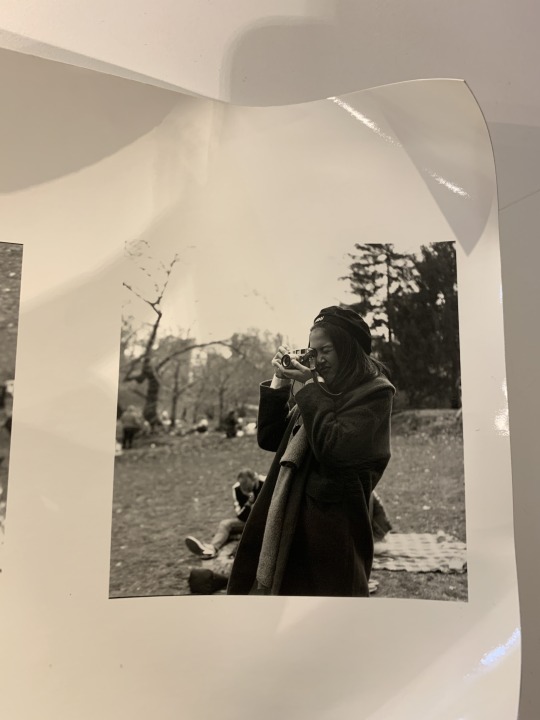
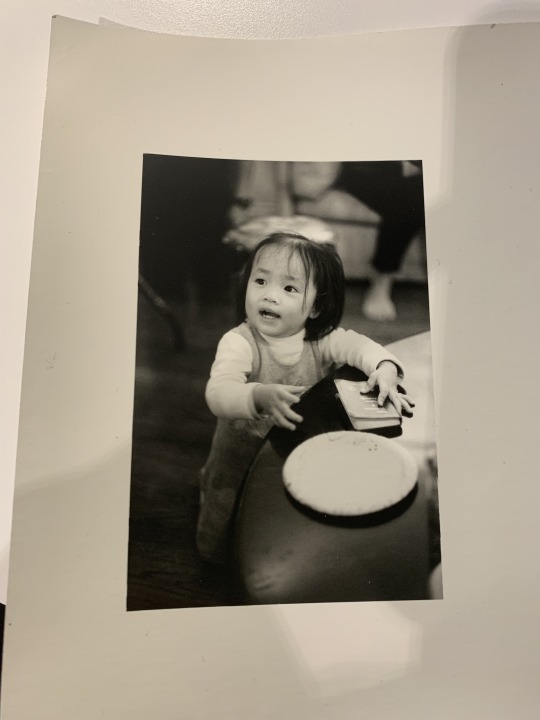

0 notes
Photo
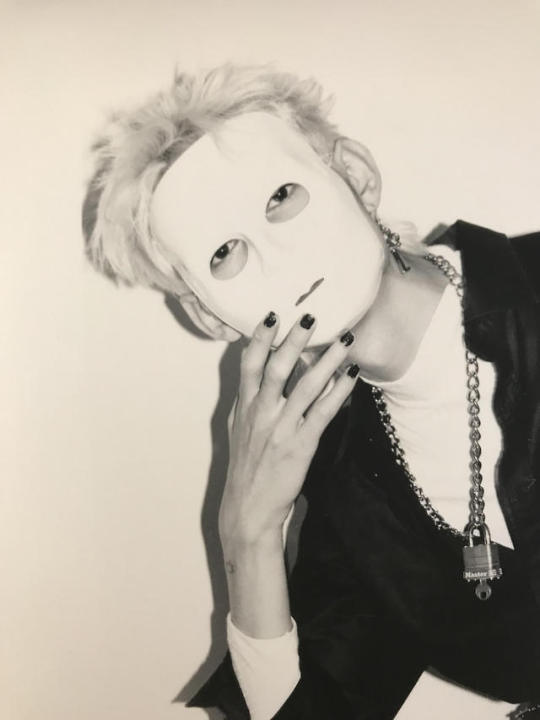
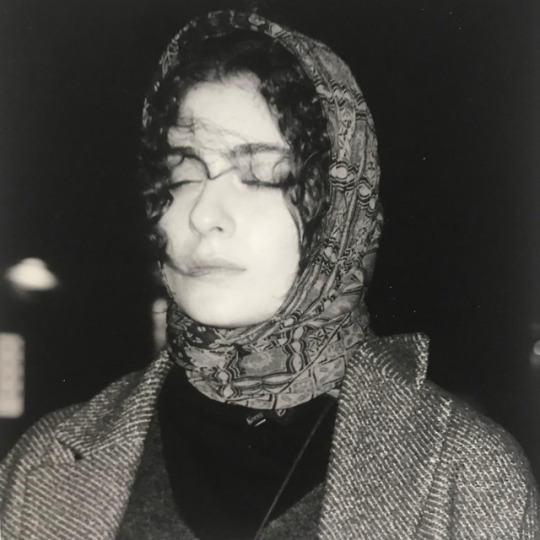

Genuinely, fake.
The quality that I value most is honesty. However, in my life there were not a lot of people who were genuine and honest with me. In this diary with a collection of photographs I want to talk about my experience of meeting “fake” and two-faced people and my feelings for them. I could never understand those who backstab, talk behind someone’s back and pretend they are someone they are not. I do not respect that. When I meet people like this it makes me feel sad, angry, and confused. I hate the fact that betrayal makes me doubt that there even is anyone that is real with me. I do not want to stop believing in the good in people.
I think that most people for some reason put on a mask every day, which makes it difficult to understand what the person is actually like. I wish everyone was not afraid to show who they are. Uncovering the layers underneath which you can see the “real” person is a tedious process that can make you either extremely disappointed or very happy and grateful.
0 notes
Photo



I am like putty, constantly molded by the people around me. These are friends, lovers, people that I love through the extension of another. I am drawn to their self-expression and authenticity, their defiance against the fixed notions of gender, sexuality, and race. These photographs were taken in quiet intimate spaces, but also at parties and out on the street, where the subjects noticeably radiate. Taking inspiration from Nan Goldin’s The Ballad of Sexual Dependency, I wanted to document my friends in a very real and intimate way, while still paying close attention to composition. While Goldin’s color photographs gives the subject matter a vibrant and immediate quality, black-and-white seems to isolate the moment in time and space, bringing the viewer closer to each subject.
Natalia Shen
1 note
·
View note



